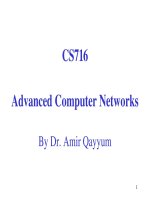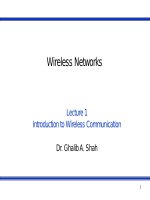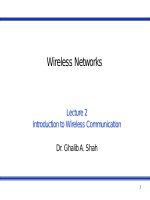Wireless networks - Lecture 44: 4G issues
Bạn đang xem bản rút gọn của tài liệu. Xem và tải ngay bản đầy đủ của tài liệu tại đây (452.05 KB, 25 trang )
Wireless Networks
Lecture 44
4G Issues
Dr. Ghalib A. Shah
1
Outline
4G Overview
► Heterogeneous Wireless networks
► Evolution
► Issues in 4G
Mobility Management
Handoffs
► Types, VHO process, VHO Issues
► Standards
QoS Considerations
2
Last Lecture
Reference Model
Burst profiles
Convergence sublayers
MAC PDU format
MAC PDU Transmission
Fragmentation / Packing
Request/Grant Scheme
Classes of Uplink service
Power management/Handoff
3
4G Overview
4G mobile communication systems tend to mean different
things to different people:
► for some it is merely a higher-capacity new radio interface,
► while for others it is an inter-working of cellular and wireless LAN
technologies that employs a variant of the Mobile IPv6 mobility
management protocol for inter-system handoff.
There is no doubt that 4G systems will provide higher data
rates. Traffic demand estimates suggest that, to
accommodate the foreseen amount of traffic in the 2010 –
2020 timeframe in an economically viable way, 4G mobile
systems must achieve a manifold capacity increase compared
to their predecessors.
researchers and vendors are expressing a growing interest in
4G wireless networks that support global roaming across
multiple wireless and mobile networks
4
a system that enables an “Always Best Connected” – or “ABC”
There are many wireless network technologies
Cellular networks, Wireless LANs, Wireless
PANs, mobile Wimax, etc.
4G networks will play a key role for integrating
various network architectures and technologies
and achieving a seamless wireless access
infrastructure
4G provides high-speed, large volume, good
quality, and global coverage to roam between
different types of technologies
5
It is widely accepted that the individual (wireless and/or
wireline) access networks will interface to core and/or
backbone network elements over the IP protocol
these wireless access networks are expected to have
the following in common:
► A dynamic address assignment mechanism (e.g., DHCP, SLP,
IPv6) that is capable of associating a short-lived or long-lived
IP address to the respective wireless interface at the mobile
terminal (e.g., Mobile IP COA association)
► A transparent IP forwarding service that is accessible over the
logical termination of the IP layer at the mobile terminal and
one or more gateways
6
Heterogeneous Wireless Networks
A mixture of co-existing radio access
technologies.
Different access technologies (radio interfaces)
and overlapping coverage.
Different network architectures and protocols
for transport, routing and mobility management.
Different service demands from mobile users
(low-data rate, high-data rate, voice,
multimedia, etc)
Different operators in the market.
7
Evolution of 4G
8
He te ro g e ne o us Ne two rks
9
Issues in 4G
Need to resolve issues as
►
►
►
►
►
►
►
►
►
Access
Handoff
Location coordination
Resource coordination to add new users
Support for multicasting
Support for quality of service
Wireless security and authentication
Network failure and backup
Pricing and billing.
10
Mobility Management
Mo bility Manag e me nt
► Location Management: enables system to track
location of mobile terminal (MT)
• Location updates and paging
► Handoff Management: the process by which an MT
keeps its connection when it moves from one point
of attachment (base station or access point) to
another
11
Handoff Management
Low signalling and processing overhead.
Minimum packet loss and delay (seamless
HO).
Guaranteeing QoS during the process and
transfer of context.
Use of any “triggers” or metrics available to
decide when and where.
Efficient use of network and MT resources.
Enhanced scalability, reliability and robustness.
Allow inter-technology handoff (VHO).
12
Handoff Types
Homogeneous (Horizontal) Handovers
► Within Single Network (Localized Mobility)
► Limited opportunities
► Mainly use received signal strength (RSS) to decide
handoff
Heterogeneous (Vertical) Handovers
► Across Different Networks (Global Mobility)
► More Opportunistic
► Handoff metric: RSS, offered bandwidth, price,
power consumption, speed, …….
13
Vertical handoff process
Step 1: “System Discovery”
Step 2: “Handoff Decision”
Step 3: “Handoff Execution”
14
Step 1: “System Discovery”
MT must know which
►
►
►
►
wireless networks are reachable.
Periodic beacons from AP.
Signal measurements.
Handoff metrics (network information) gathering:
Bandwidth, cost, delay, SNR, power, etc.
► Periodic network scanning.
► All interfaces always on.
15
Step 2: “Handoff Decision”
MT then evaluates the
► Some example policies:
•
•
•
•
“Always us e the che ape s t ne twork”.
“Always us e the inte rface with lowe r powe r cons um ption”.
“Always us e the W LAN”.
“Always us e the ne twork with m ore bandwidth”.
► Decision may be based on utility / cost functions.
16
Step 3: “Handoff Execution”
If MT decides to perform a VHO, it executes
the VHO procedure required to be associated
with the new wireless network.
17
VHO Issues
When to switch?
► VHO policies
► WLAN to Cellular ≠Cellular to WLAN
Seamless handoff
► Packet loss and VHO latency.
Load balancing between networks.
QoS guarantees
Security and Authentication.
Billing
Implementation.
18
Standardization Efforts
IETF
► Mobility for IPv4 (MIPv4)
► Mobility for IPv6 (MIPv6)
► Mobility for IP: Performance, Signalling and Handoff
Optimization (MIPSHOP)
IEEE 802.21 Media Independent Handover Group is
working toward the seamless handoffs between IEEE
802.XX family and 3G Cellular
3GPP and 3GPP2 are working in inter-working with
WLAN as an extension of their radio access networks.
► Loosely Coupled Architecture
► Tightly Coupled Architecture
19
Tightly coupling
► Provides common charging and billing service
► Provides mobility support using traditional 3G
technology
► Reuses 3G service (e.g., SMS, MMS, etc.)
► Causes large traffic load in 3G core network
Loosely coupling
► Provides simple integration approach
► Needs minimal requirement on the access network
► Provides independent network management
20
QoS
Supporting QoS in 4G networks will be a major
challenge due to varying bit rates, channel
characteristics, bandwidth allocation, faulttolerance levels, and handoff support among
heterogeneous wireless networks.
QoS support can occur at the
►
►
►
►
Packet,
Transaction
Circuit
User
21
Packe tle ve l QoS
► applies to jitter, throughput, and error rate.
► Network resources such as buffer space and access
protocol are likely influences.
Trans actionle ve l QoS
► describes both the time it takes to complete a
transaction and the packet loss rate.
► Certain transactions may be time sensitive, while
others cannot tolerate any packet loss.
22
Circuitle ve l QoS
► includes call blocking for new as well as existing
calls.
► It depends primarily on a network’s ability to
establish and maintain the end-to-end circuit.
Us e rle ve l QoS
► depends on user mobility and application type.
► The new location may not support the minimum QoS
needed, even with adaptive applications.
23
Endto End Qo S
Developers need to do much more work to address
end-to-end QoS.
► They may need to modify many existing QoS schemes,
including admission control, dynamic resource reservation, and
QoS renegotiation to support 4G users’ diverse QoS
requirements.
A wireless network could make its current QoS
information available to all other wireless networks in
either a distributed or centralized fashion so they can
effectively use the available network resources.
Additionally, deploying a global QoS scheme may
support the diverse requirements of users with different
mobility patterns.
24
QoS Parameters
802.11e
►
►
►
►
►
UMTS (Release 5)
►
►
►
►
►
Nominal MSDU size
Min/mean/max data rate
Mean/max service interval
Traffic type (isochronous, asynchronous)
Burst size
Traffic class (conversational, streaming, interactive, or background)
Guaranteed, maximum bit rate
Maximum SDU size
SDU/bit error ratio
Transfer delay
802.16-2004
►
►
►
►
►
►
Traffic priority
Maximum sustained traffic rate
Maximum traffic burst
Minimum reserved traffic rate
Scheduling type (best-effort, non-real time polling, real-time polling, unsolicited grant)
Tolerated jitter, maximum latency
25









